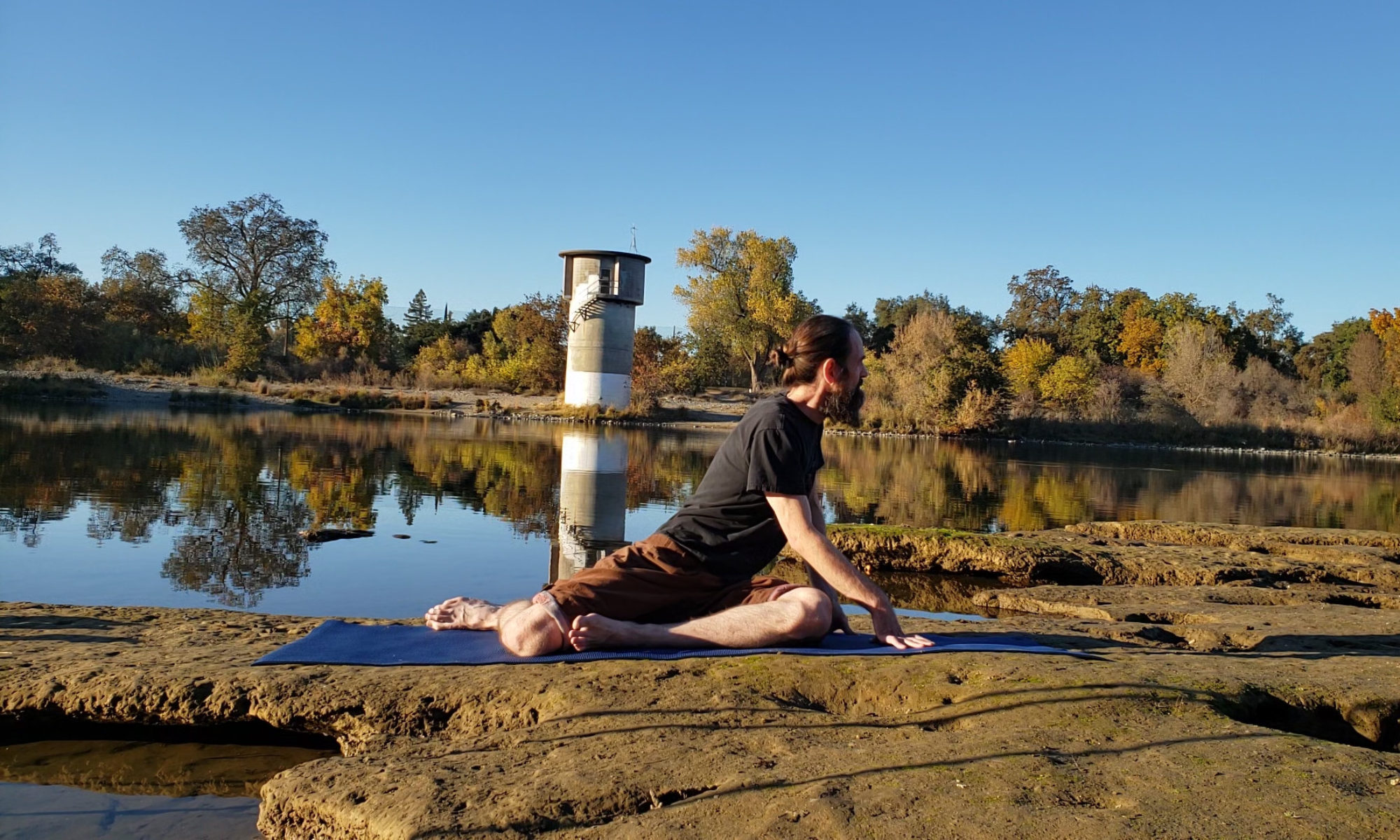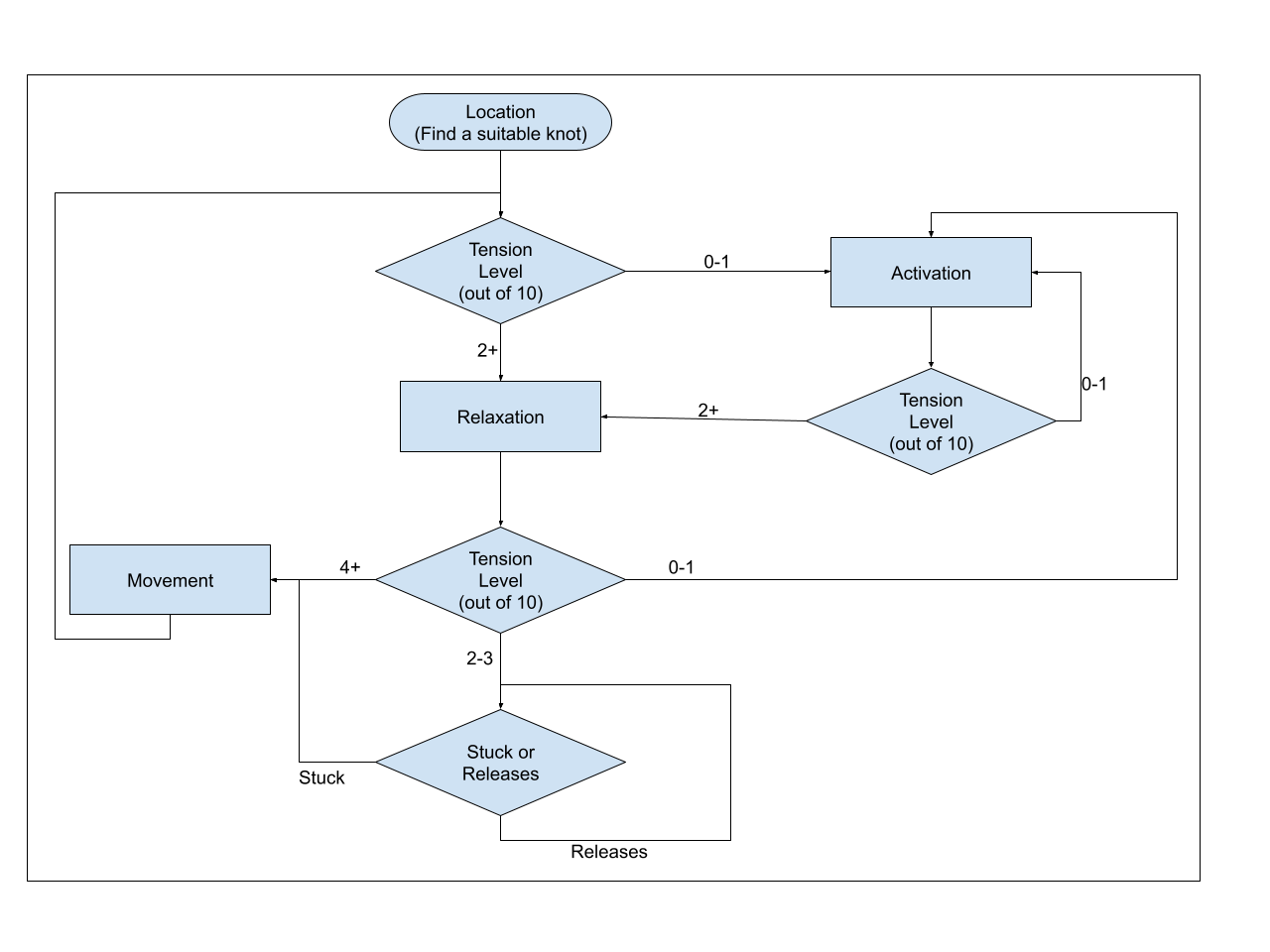I usually describe sequential stretching™ as a method of moving to many specific, slightly different body poses and relaxing each one. That is how I started doing it myself and it is the easiest method for me to describe and demonstrate, but it is no longer how I spend most of my stretching time. Although I usually start my stretch sequences like that, I spend most of my time playing with my knots and doing freeform stretching. Describing those techniques is complicated, but I believe they are the most effective way to stretch.
Table of Contents
- Playing With Knots
- The Flow of Knot Play
- Descriptions of Each Stage
- Playing with Knots Example
- Freeform Stretching
- Freeform Stretching Example
- Benefits of Freeform Stretching
Playing With Knots
Playing with knots is a type of sequential stretching where the focus is on locating, testing, and releasing muscle knots instead of focusing on relaxing a range of movement. It is a method of positioning, relaxing, and activating your body in ways that allow you to sense and release the layers of tight muscle fibers that make up muscle knots. It is performed by first locating an accessible knot, then choosing between two tension release techniques: relaxation and activation. When those techniques stop producing significant tension release or cause the tension level to rise too high, make small pose or movement changes to get the releases flowing again.
The Flow of Knot Play
The following flowchart gives an overview of how to play with a knot and when to move between different stages, starting at Location:
Playing with Knots Stages
- Location is the first step to playing with knots and is focused on finding a knot that can be played with. A good way to start is to choose a stretch sequence, get relaxed in the starting pose, and then proceed with the movements until you locate a slightly tense area. Try to picture this tight muscle area in your mind and see if you can imagine the size and shape of the knot causing it. This mental image doesn’t need to be precise. It just needs to be approximate so you can use other techniques to refine the image later. If the tension level sensed is very low (0 to 1 out of 10), move to the Activation stage. If tension levels are higher (2+ out of 10), move to the Relaxation stage.
- Relaxation is done when sensed tension levels rise to level 2 (out of 10) or higher with a goal to reduce tension levels to between levels 0 and 1. This is done using SPPM with a control point chosen at least a few inches away, but ideally two feet or more, from where you feel the tightness. Start by using big exhales to relax the tightness while keeping the control point at the same location in space. If the tension level drops down to level 0 (no tension sensed) or level 1 (very gentle resistance), proceed with the Activation step. If the tension gets to level 2-3, listen closely for microreleases. Stay here if the releases keep coming. Proceed with the Movement stage if your body seems stuck at this tension level and you don’t sense any tension releases.
Sometimes this type of relaxation will actually increase the tension level you sense. This can usually be solved by decreasing the depth of the stretch. It may seem backward that you have to decrease a stretch when you relax, but this is one case where a step back is needed to make progress on releasing a knot system. This can happen when releasing active parts of a knot causes dormant parts of the knot to activate to compensate. If you can relax the shallower stretch, slowly proceed back to the depth you were at previously to see if you can relax that position. If the shallower position remains at level 2 tension or higher after relaxing, go to an even shallower position until you can relax down to level 0 or 1. It may help to move back and forth to different depths a few times, relaxing at each position until you feel the knot has released or you become fatigued.
There may be times during relaxation when you sense a large amount of unnecessary tension may be about to be released. Use some caution when this happens, as releasing too much tension all at once can cause overall tension levels to quickly rise too high or spasm and force you to abort the stretch. When you sense a large bunch of tightness can be released, try just letting go of half or a quarter of the tightness. This means giving in to some of the urges to tighten up and maybe even reinforcing some of those tightening urges for a few seconds so that the releases can be done in stages instead of all at once. This can allow you to continue with the stretch sequence for longer and release muscle fibers that might take a long time to access. However, it can also be effective, but riskier, to just let all the tightness go at once to see what happens.
- Activation should be performed when sensed tension levels fall back to level 0 or 1. Activation is about gently increasing the tension level by adjusting your body positioning or body expansion to a level that is slightly more difficult to keep relaxed. There are several ways to trigger activation. One way is by shifting your balance point slightly in one direction and trying to re-relax. Another method is to perform some targeted microexpansions along specific locations of the area of interest. A third method is to perform an area expansion in a location near the knot being targeted. The last method is to gently press part of your body that is touching or nearly touching the floor further into the floor. Both the microexpansions and area expansions are best done in muscle areas near the knot where nothing is being felt, as this may alert your brain to secondary tension that may be contributing to the knot of interest. When tension levels rise to 2+, proceed with the Relaxation stage.
- Movement is done when relaxation doesn’t lower the tension level below 4 or level 2-3 without any sensed tension releases. This should be a gentle, slow movement to a position that you expect will feel less of a stretch. Typically this will be a small reverse movement back toward your starting position. If the tension level sensed at this new position is very low, move to the Activation stage. If tension levels are higher (2+ out of 10), move back to the Relaxation stage.
The location where tension is felt may shift dramatically as one muscle area is released and another tightens up to compensate. This tightening feeling may not actually be increased tension, but increased perceived muscle tension. When the brain senses the exact same tension for long periods of time, it eventually tunes out that signal. When the tension signals change, your brain stops ignoring them and alerts your consciousness. This is normal and should be seen as a sign that progress has been made, even if the tension level felt is higher than before for the same body positioning. Tension must be felt before it can be released, so you should view those tight sensations as the first step to releasing that tension.
Playing with Knots Example
An example of playing with knots goes like this:
- I begin by centering myself in my chair, so I feel balanced and completely relaxed. I remind myself that I can feel almost exactly that relaxed no matter how wide my throat opens
- I gently open a singer’s expansion just to the point of sensing some resistance to the current expansion level.
- I feel a level 2 (out of 10) tightness in the back of my throat.
- I focus my thoughts on where I feel that tightness. It feels like it connects from the back of my throat to the back of my jaw.
- I back off my expansion, prioritizing relaxation. My gentle awareness of the back of the throat tightness lowers the tightness sensed to level 1, while still maintaining the (slightly smaller) singer’s expansion.
- I remind myself that this gentle level 1 tightness (or level 0) should be all that is felt if my head were moved in any direction from the current pose. I make a few tiny, gentle head movements, pointing my nose slightly up and down, feeling small pops in the lower back of my throat.
- I slowly increase the size of the gentle head movements, keeping the expected tension level low as I perform a tension visualization.
- I find the level 2 tightness come back. I relax the area until it comes back to level 1.
- This time I try sending some light area expansions in the area where the tightness is felt.
- I sense some brief level 3 tightness that quickly crackles in the back of my throat and moves to a level 1 tightness.
- I next sense tightness building much deeper in my throat. I shift my tension visualization efforts to this area.
- I send gentle relaxation signals.
- I sense pops in the back of my throat an inch or two away from the level 2 tightness.
- I focus on getting back to a totally relaxed feeling in my entire throat.
- I might repeat this several times, updating my tension map each time.
Freeform Stretching
Freeform stretching is also done as a sequence of poses, but much more improvised, with much fewer pre-planned movements and more going with the flow. It allows the focus of a stretch to change significantly with how your body feels and keeps the stretch session interesting and varied, like an open-world video game. The improvised nature also allows me to discover new stretches that work for my body that I may never have considered before. It is an excellent companion to playing with knots,
Freeform Stretching Example
I’ll give an example:
- I start by beginning a standing fold.
- I make it one-quarter of the way down and get a sense of lower back tightness that seems to be creeping up in tightness instead of releasing.
- I then pause for a while and try to relax that lower back tightness with some SPPR technique by focusing on positioning my chest and feet while relaxing the rest of my body. I get a few minireleases, but sense that this lower back knot would have an easier time releasing if I reverse directions.
- I start moving my chest upward and feel more satisfying cracks and pops.
- I start visualizing this lower back knot, which makes me want to know more about its shape and size to get a more accurate picture in my head.
- This leads me to start to move my upper torso a bit to the left to see how wide the knot goes on that side.
- Then, I move back to the center and check the right side for a bit. I feel some of the tension from my lower back release for a bit, but start feeling my right ankle tightening up to maintain balance.
- I shift my focus to moving my center of gravity to more closely align with my balance point so that my right ankle can relax. I feel my right ankle let go.
- I start doing some microexpansions of my right ankle and calf to test if they are truly relaxed. The ankle tightens back up quickly and stays tight despite attempts to relax it.
- I decide to leave the ankle alone, but feel my balance is a bit off-center again.
- This leads me to be curious as to how my left ankle would respond to a microexpansion. I attempt gentle microexpansions of the left ankle and feel a bit more balanced.
- This feeling of being balanced leads me to want to try feeling balanced with my weight in different directions, so I gently shift a tiny bit of weight to the balls of my feet. This makes me feel like I am pressing my feet into the ground.
- I counter this by trying to lift the balls of my feet while keeping my upper body in place. I am unable to lift the balls of my feet from the floor, but attempting it causes some tight muscles to let go in my ankles.
- I then try pressing the balls of my feet firmly into the floor and relax without moving my upper body.
Benefits of Freeform Stretching
This type of freeform stretching game makes the stretching experience more varied and less robotic. It becomes more like a video game where I am trying to score points by releasing some tension. It also allows me to stretch a lot of different muscle groups while building my understanding of the connections between tightness in different areas.


